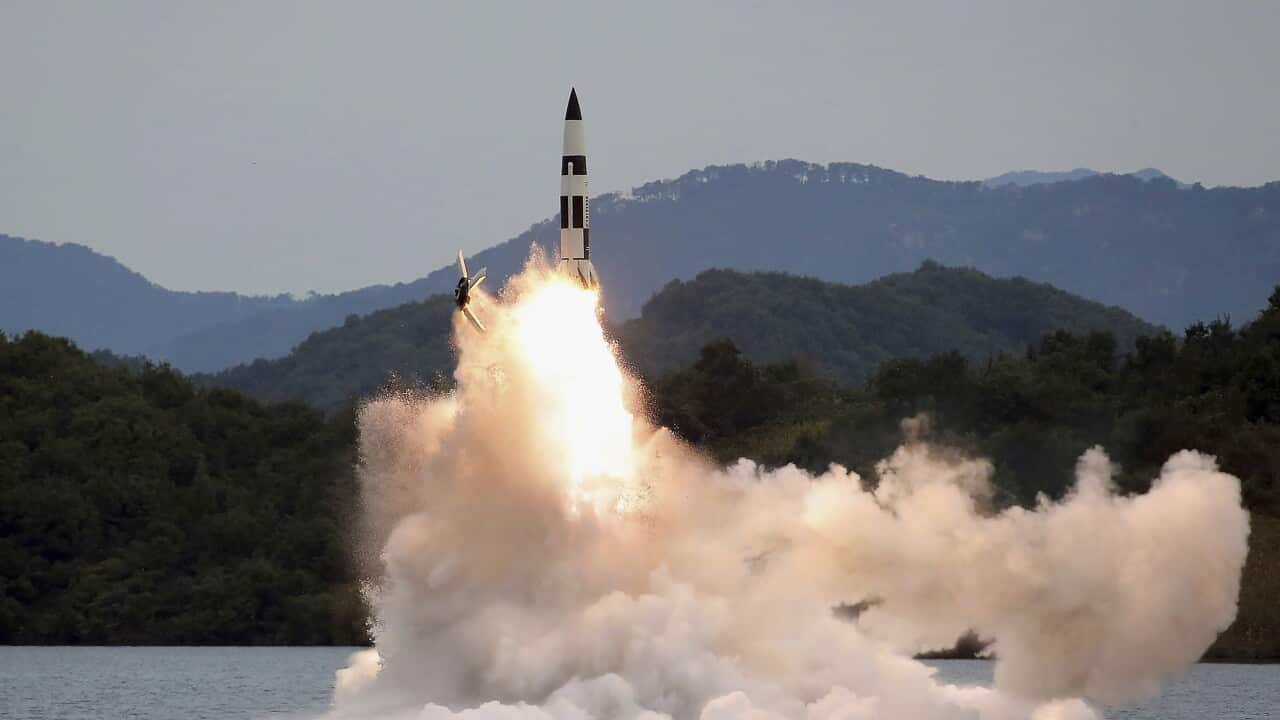North Korea has caused concern in the east Asian region after testing ballistic missiles, some flying over Japanese and South Korean airspace.
Missile tests have surged under the leadership of Kim Jong-un, leading to strong warnings from the US, Japan, and South Korea to prevent further escalation.
So just how dangerous is North Korea's arsenal, and should Australians be concerned?
Long-range missiles and more: What's in North Korea's arsenal?
North Korea has recently been testing ballistic missiles, cruise missiles and hypersonic missiles.
On 3 November, the Japanese government issued a warning for Tokyo residents to immediately seek shelter after Pyongyang launched what was suspected to be an intercontinental ballistic missile (ICBM), among several other missiles, that entered Japanese airspace.
Japanese Defence Minister Yasukazu Hamada said the first missile was launched on a potential trajectory over Japan but that it disappeared from radars over the Sea of Japan.
"We detected a launch that showed the potential to fly over Japan and therefore triggered the J Alert, but after checking the flight we confirmed that it had not passed over Japan," Mr Hamada told reporters.
The warnings came one day after Pyongyang launched other missiles landing less than 60 kilometres off the coast of South Korea, leading Seoul to respond with missile tests of its own.
Residents of an eastern South Korean island were told to evacuate after the missiles were detected.

South Korean army soldiers stand in front of the debris of a missile which the Defense Ministry identified as a North Korea's SA-5 surface-to-air missile. Credit: Han Sang-kyun/AP
The longest range missile is the Hwasong-17, which has range of over 15,000 kilometres.
The Hwasong-17 is assumed to be a two-stage, liquid-fuelled road-mobile ICBM carried by a 22-wheeled transporter erector launcher vehicle.
It's estimated to be 26 metres long with a diameter of 2.7 metres.
Other long-range missiles in North Korea's arsenal include the Hwasong-15, which has a range of around 13,000 kilometres, and the Hwasong-14 which has a range of 10,400 kilometres.

North Korea's nuclear capabilities
North Korea's Hwasong-17 could likely carry three or four nuclear warheads, giving it a significant advantage over previous missiles in its arsenal which could likely only carry one.
The last time Pyongyang tested a nuclear weapon was in 2017, at its Punggye-ri test site.
It claimed it was a test of its first thermonuclear device—the most powerful type of nuclear weapon—and was more than six times more powerful than the bomb the US dropped on Hiroshima in 1945.
Some experts fear that rising tensions between Pyongyang and Seoul could lead to nuclear war.
"The greater risk is that North Korea provokes South Korea and South Korea responds, and then North Korea retaliates with nuclear weapons," Senior Analyst in Defence Strategy and Capability at the Australian Strategic Policy Institute, Malcolm Davis, told SBS News.
"Under US extended nuclear deterrence, the US would strike back at North Korea, or potentially try to prevent the use of North Korea nuclear weapons in the first place."

The North Korean government's supplied image of what it says is a test-fire of a Hwasong-17 intercontinental ballistic missile (ICBM), at an undisclosed location in North Korea on 24 March 2022. Credit: Korean Central News Agency/AP
"We think they're ready to go. Kim just has to give the thumbs up," a senior US State Department official told CBS News.
"I think the drivers for North Korea to do something is higher than I think I've seen, and I base that on just their statements.
"We're keeping a close eye on whatever potential localised conflict could happen."
In September, Mr Kim declared North Korea a "nuclear weapons state" and said the country would never give up its pursuit of developing nuclear weapons.
"The purpose of the United States is not only to remove our nuclear might itself, but eventually forcing us to surrender or weaken our rights to self-defence through giving up our nukes, so that they could collapse our government at any time," Mr Kim said in the speech published by the North's official Korean Central News Agency.
"Let them sanction us for 100 days, 1,000 days, 10 years or 100 years.
"We will never give up our rights to self-defence that preserves our country's existence and the safety of our people just to temporarily ease the difficulties we are experiencing now."
Is Australia prepared?
Mr Davis said it's unlikely North Korea would attack Australia, and that the US is under greater threat.
"Certainly North Korean ICBMs could reach Australia, carrying nuclear warheads, but Pyongyang is unlikely to attack Australia," he said.
"Their ICBMs are really there to deter or attack the United States. Secondly, in regards to conflict with North Korea, we are part of the United Nations command on the peninsula, but it is unlikely that we’ll get heavily involved in fighting from the outset."
Mr Davis said Australian forces would more likely be involved in a post-conflict situation.
"Certainly we could send air and naval forces to support the United States in any conflict, but it is more likely that we would send ground forces in the aftermath to stabilise the situation and enforce peace," he said.
The Australian Department of Defence has been contacted for comment on how prepared it is for potential long-range missile attacks from foreign forces.



